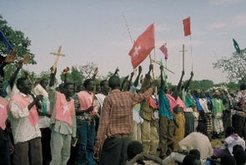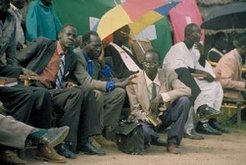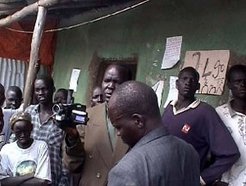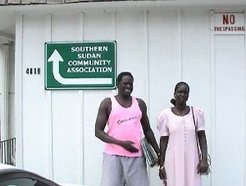Nuer vernacular modernism in Ethiopia and the USA

This project is about vernacular modernism of Nuer in a transnational social field which consists of relationships between Nuer from Africa and the USA and their life-worlds. It is based on 13 months of fieldwork in refugee camps and villages in Africa and Nuer settlements in urban areas in the Midwest of the USA. Since colonialism and missionary efforts the Nuer and the rest of the world have mutually been influencing each other, but it is only very recently that they have been integrated into a global economy. Their war against the Government of Sudan and its side effects on them in the form of refugee camps, a relief industry and non-governmental organisations (NGO's) as well as their outmigration to the USA are manifestations of their globalization.

The experience of war and military rule further undermined the Nuer understanding of politics, their concepts of order and led to a deterioration of norms. As a part of these norm breaks anonymous homicide and homicide against women are increasing and cleansing rituals which used to regulate the identification of the slayer and compensatory payments are no longer followed by all members of society. Apart from the negative impacts of war, changing political, economic and ecological conditions lead to a deterioration of the cattle economy, monetization and the demand for modern commodities in the villages. Similarly long lasting stays in Ethiopian and Kenyan refugee camps have contributed to major changes in the Nuer social organisation, specifically the rise of Christianity as well as the value of literacy as it is closely linked to the latter. The Nuer encounters in towns, urban-like refugee camps and the stereotypes by their neighbours made them feel 'backward' as compared to other peoples in the world. Hence, they have decided to join the world (bako ro mat rey naath) which they primarily do by seeking education as an all-fit exit strategy to their problems. This makes us understand the present velocity with which contemporary Nuer join schools and the level of sacrifice they are ready to make by taking the burden of living on scarce resources of relatives in the towns or refugee camps. For them, education and Christianity are means to overcome their backwardness'.

In this context Donald Donham has made some useful distinctions concerning concepts around modernity which are about the description of local people's own ideas of the modern. He defines modernity as a "wider cultural conversation, in which modernists are typically a dominant part, but which includes others from traditionalists to post-modernists. His related concept of vernacular modernism fits to the Nuer idea of 'joining the world' as local attempts to reorder society by applying strategies that have produced wealth power, or knowledge elsewhere in the world. Although I agree that modernity also has material underpinnings, the effects of the world capitalist system are not necessarily material in all locations, especially in places like the Nuer areas, where a capitalist economic transformation has so far remained of marginal impact. Hence, in the Nuer case, vernacular modernism does not necessarily involve economic transformation but is a lot about symbols, ideas and transnational networks. As already mentioned the study is not about a society in a fixed location but about Nuer in a social field which according to Glick Schiller is composed of interlocking networks of interpersonal connections that stretch across borders. (Glick Schiller: forthcoming: 2004) The establishment of their social field which consists of new religious and political institutional affiliations stretching from their homeland through countries of exile in Northeast Africa up to the USA, is part of the Nuer endeavour to modernize.

As part of their networking Nuer in Omaha, Nebraska, have organised the first functioning Southern Sudan Community Association Discussions on the constitution and election Procedures of the newly established descent based Maiwut Association in Omaha.
The church, developmental and political networks are linked by a Venn diagram like clustering of Nuer descent groups which are polyvalent in a sense that descent overlaps with political and religious grouping. These polyvalent descent groups are mirrors of the segmentary system ( Christian Segmentation in Pinyudo Refugee Camp) of the Nuer since descent has remained the basis for most forms of Nuer organisation. The project will focus on these polyvalent groups and their linkages to institutional networks within a transnational social field as well as depict reasons for the lack of functional differentiation as a seeming subversion of modernity. The fore and back visits of their relatives as well as media have contributed to imaginations of a new world in which war, destruction and lack of modern facilities are non-existent. On the one hand they imagine a world of peace and development, ultimately achieved through education and new modes of employment.On the other hand however they fear to be crushed by global capitalism, the news of which, the more Nuer experience it in the USA, simultaneously reaches and scares an increasing number of those still living in the villages or refugee camps. This research tries to find out reasons for being attracted by modernity, how it is assessed as well as which parts are rejected. Hence, it is an attempt to describe their wider cultural conversation over changes related to their encounter with a modern world. In their imaginations of a new world, the present misery of war, destruction and lack of modern facilities are left behind. They are replaced with an idea of peace, ultimately achieved through education. In this conversation some Nuer groups claim that they are no longer the Nuer of before (ci ney la nueeri tee wal) which at the same time functions as a legitimizing strategy to assess the modern world. However, their conversation also comes up with ambivalence in their view of modernity as it appears in a simultaneous critique and appreciation of both 'tradition' and modernity. Hence, their attitude does not entail a total dismissal of their past nor does it intend to fully subject to modernity. Therefore, rather than adopting a bounded, opposing view of tradition and modernity, the project is about boundary drawings between different realms which are drawn and subverted and never clear.



